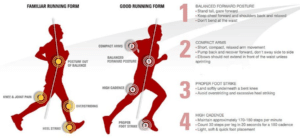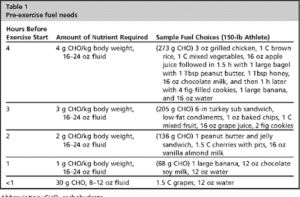Running Tips & Tricks
How to get to the finish line
One of the most popular events in Miami is taking place this month- the Miami Corporate Run! We here at Symmetry are passionate about exercise and sports performance. We will briefly discuss how to address the run from your running form, injury prevention, and general nutrition.
Here are some running tips! The goal of running is to get from point A to point B as quickly as possible. That requires moving in the horizontal direction as efficiently as possible and minimizing any unnecessary motion in the other planes. Inefficient movement patterns while running can lead to an overuse injury and waste of energy causing decreased performance.
Movement Patterns
Movement patterns that decrease efficiency include increased vertical displacement, poor shock attenuation, and poor alignment. Vertical ground reaction forces during running are typically about 2-3x bodyweight. Running at slower speeds or with longer strides results in an increased in vertical displacement causing increased vertical ground reaction forces and braking impulses. This will cause increased stress to the hip and knee joints to absorb the increased forces.
How to Prevent Injury with Correct Form
As movement experts, we recommend some strategies to mitigate the excessive forces to your joints while running. One strategy we recommend is to increase your cadence. An increase in step rate (cadence) to 10% more than your typical self-selected pace will help to decrease vertical displacement, causing decreased: forces at knee and hip joints, compressive stresses to patellofemoral joint, braking impulse, and peak valgus moments (hip adduction and internal rotation). (Heiderscheit 2011)
A slight increase in a forward trunk lean will also help to decrease compressive stresses at the knee. Optimal cadence is about 180 steps per minute, however, it is most beneficial to individualize your cadence to 10% faster than your typical self-selected pace. Shortened stride length and increased cadence will help to improve movement efficiency and performance, as well as decrease the risk of injury. Would you like more individualized recommendations? Have specific questions you need to be answered? Come into Symmetry PT for a full running evaluation!
Proper Form
Maintaining proper form during your run will help with movement efficiency and injury prevention. Be aware of your posture, stride, and breathing throughout the run, especially towards the end when fatigue starts to kick in. Keep your shoulders in a relaxed and neutral position with your gaze directly ahead and your ears in line with your shoulders. Keep your elbows bent at 90 degrees with a soft grip in your fingers. A common cue to help maintain a relaxed grip is to think of holding a potato chip between your thumb and index finger.
2qControl upper body rotation by keeping your arms pumping from front to back in the sagittal plane. Maintain a tall spine with a slight forward lean at the hips. Contact the ground with your foot directly underneath you to reduce braking impulse. Lastly, keep your breathing pattern as normal as possible by utilizing your diaphragm and minimizing accessory muscle use. Try breathing through your nose while taking deep breaths and avoid shallow chest breathing.
Energy Sources for Running
Main energy sources for the human body are fats, carbohydrates, and protein while water serves multiple purposes of ensuring major energy pathways are functioning normally. Water also serves as a medium to which healthy muscle contractions may occur (hence why dehydration leads to cramping, which we all know feels terrible). For nutrition, the main topics to be addressed will be water, carbohydrate, and protein intake prior to, during, and after your run.
Carbohydrate Intake
It is recommended to consume carbohydrates prior to exercise. Ideally, you want to begin fueling up on about 4 g of carbohydrates/kilogram of body weight about 4 hours prior to your run. But, if you have less time, you may need to make adjustments to this plan. Zoorob et al. 2013 wrote an excellent article summarizing the recommendations and sample food choices to give you an idea of what to consume in preparation:
Post-exercise carbohydrate intake:
Best to intake about 1-1.5 g/kg within the first 30 minutes, 1-1.2 g/kg/hr from early recovery through 4-6 hours.
Protein Post-Workout
Lastly, protein does not offer any substantial form for energy use during cardiovascular exercise. However, consuming 20-30 grams of protein would be ideal within 30 minutes following physical activity. We recommend consuming about 0.2g/kg within the first 30 minutes to improve muscle repair.
Hydration is Key
- For your water intake, we recommend consuming approximately 5-7 mL/kg (of body weight) at least 4 hours prior to the activity. (340-476 mL for 150 lbs. athlete)
- Research is varied when it comes to how much water is enough during an exercise bout, but the current recommendations are to consume about 0.4 L/hour to 0.8 L/hour. (400-800 mL/hour)
- Post-exercise it is recommended by the American Dietetic Association to drink about 16-24 fluid ounces of water for every 1 pound lost during physical activity. (16oz = 473mL) Replenishment may take upwards of 6 hours to occur following physical activity.
- A light beer post-run is actually not bad for rehydration! Alcoholic beverages <4% in alcohol actually do not negatively affect hydration levels.
Conclusion
We are looking forward to running with you all of you so keep an eye out for Team Symmetry PT! If you have more specific questions or would like individualized advice, don’t hesitate to give us a call at Symmetry PT to come in for an evaluation. We are passionate about movement and want to help you feel your best to be able to crush your coworkers during the run! Want to see more? Check out our Youtube channel.


